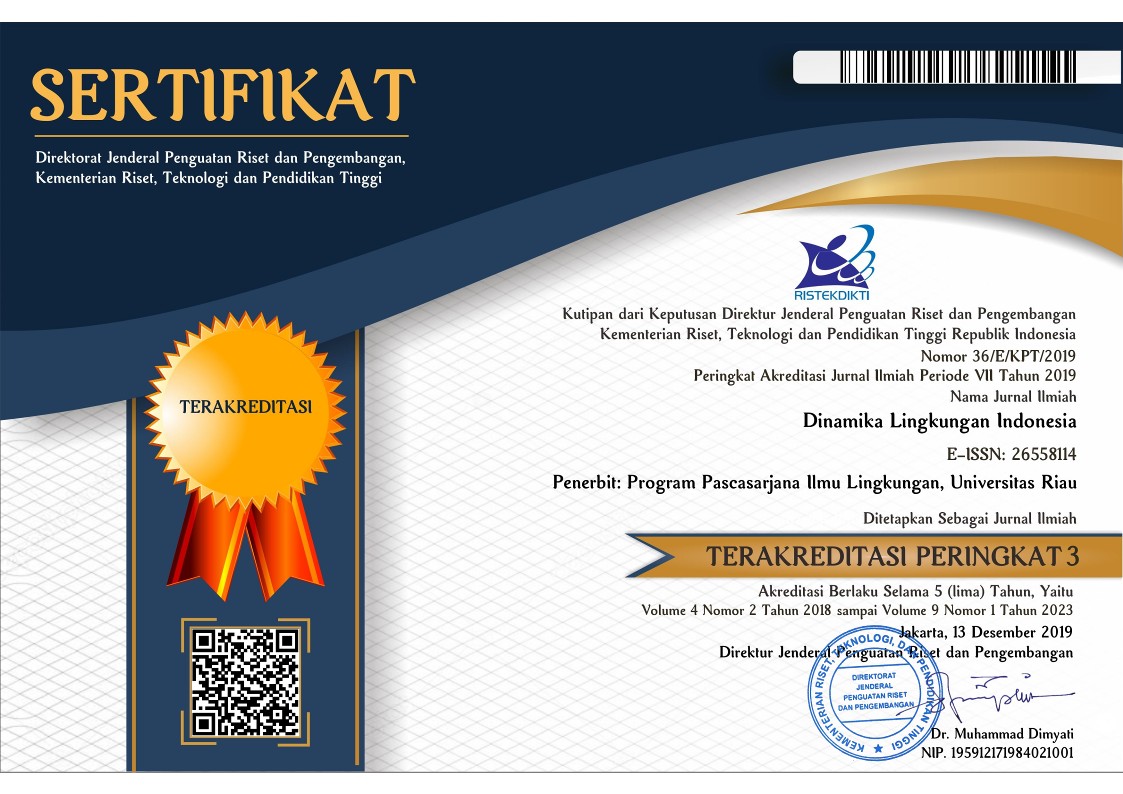Ancaman keanekaragaman hayati (Biodiversity) terhadap ekosistem daerah penangkapan pukat hela
Abstract
Keywords
Full Text:
PDFReferences
Alverson, D. L., Freeberg, M. H., Pope, J. G., & Murawski, S. A. (1994). A Global Assessment of Fisheries Bycatch and Discards. FAO Fisheries Technical Paper No. 339. Rome: FAO.
Alverson, D. L., & Hughes, S. (1996). Bycatch: from Emotion to Effective Natural Resource Management. Fish Biology and Fisheries. 6(4): 443–462. DOI : https://doi.org/10.1007/BF00164325.
Borges, L., Rogan, E., & Officer, R. (2005). Discarding by The Demarsal Fishery in The Waters Around Ireland. Fisheries Research. 76: 1-13. DOI: 10.1016/j.fishres.2005.05.011.
Broadhurst, M. K., Millar, R. B, Wooden, M. E. L., & Macbeth, W. G. (2006). Optimising Codend Configuration in a Multispesies Demarsal Trawl Fishery. Fisheries Management and Ecology. 13: 81-92. DOI : https://doi.org/10.1111/j.1365-2400.2006.00479.
Cedrola, P. V., Gonzalez, A. M., & Pettovello, A. D. (2005). Bycatch of Skates (Elasmobran-chii: Arhynchobatidae, Rajidae) in The Patagonia Red Shrimp Fishery. Fisheries Research. 71: 141-150. DOI : https://doi.org/10.1016/j.fishres.2004.08.031.
Crowder, L., & Murawski, S. (1998). Fisheries Bycatch: Implications for Management. Fisheries 23(6): 8–16. DOI: https://doi.org/10.1577/1548-8446.
Diamond, S., Crowder, L., & Cowell, L. (1999). Catch and By-catch: The Qualitative Effects of Fisheries on Population Vital Rates of Atlantic Croaker. Transactions of the American Fisheries Society. 128: 1085-1105. DOI : https://doi.org/10.1577/1548-8659.
Eayrs, S. (2005). A Guide to Bycatch Reduction in Tropical Shrimp-Trawl Fisheries. Rome, Italy: Food and Agriculture Organization (FAO) of the United Nations.
Fonseca, P., Campos, A., Larsen, R. B., Borges, T. C., & Erzini, K. (2005). Using A Modified Nord-more Grid for By-catch Reduction in The Portuguese Crustacean-trawl Fishery. Fisheries Research. 71: 223-239. DOI: 10.1016/j.fishres.2004.08.018.
Grimaldo, E., & Larsen, R. B. (2005). The Cosmos Grid: A New Design for Reducing By-catch in The Nordic Shirp Fishery. Fisheries Research. 76: 187-197. DOI: 10.1016/j.fishres.2005.06.010.
Hall, M. A., Alverson, D. L., & Metuzal, K. I. (2000). By-catch; Problems and Solutions: Seas at Millennium: An Environmental Evalua-tion. In: Sheppard, C.R. (Ed.), Global Issues and Processes.
Hall, S. J., & Mainprize, B. M. (2005). Managing By-catch and Discards: How Much Progress Are We Making and How Can We Do Better? Fish Fish. 6(2): 134–155. DOI: https://doi.org/10.1111/j.1467-2979.2005.00183.
Harrington, J. M., Myers, R. A, & Rosenberg, A. A. (2005). Wasted Fishery Resources: Discard By-catch in the USA. Fish and Fisheries. 6: 350-361. DOI: https://doi.org/10.1111/j.1467-2979.2005.00201
Harris, A., & Huang, A. (2001). Assessing the Effect of Fishing on Non-target Spesies in Commonwealth Fisheries. Report to the Fisheries Resources Research Fund. Australian Department of Agriculture, Fisheries and Forestry, May 2001, Canberra.
Jennings, S. (2005). Indicators to Support An Ecosystem Approach to Fisheries. Fish and Fisheries. 6: 212-232. DOI: 10.1111/j.1467-2979.2005.00189.
Jennings, S. (2007). Reporting and Advising on the Effect of Fishing. Fish and Fisheries. 8: 269-276. DOI: 10.1111/j.1467-2679.2007.00250.
Kelleher, K. (2005). Discards in the World’s Marine Fisheries: An Update. FAO Fisheries Technical Paper No. 470. Rome, Italy: Food and Agriculture Orga-nization of the United Nations.
Krebs, C. J. (1985). The Experimental Analysis of Distribution and Abudance. Ecology. New York: Harper dan Row.
Nofrizal & Arimoto, T. (2017). Histological Approach on the Lateral Line Organ of Jack Mackerel (Trachurus japonicas) for Mechanical Sensing in Swimming Behavior. Journal Sustainable Science and Management. 12(1): 23-29.
Nofrizal, Romie, J., Yani, A. H., & Alfin. (2018). Hasil tangkapan sampingan (bycatch dan discard) pada alat tangkap gombang (fulter net) sebagai ancaman bagi keslestarian sumber daya perikanan. Marinr Fisheries 9(2):221-233.DOI: https://doi.org/10.29244/jmf.9.2.221-233.
Purbayanto, A., S. H., Wisudo, J., Santoso, M., Wahyuni, R. I., Wahyu, Dinarwan, Zulkarnain, Sarmintohadi, A. D., Nugraha, D. A., Soeboer, B., Pramono, A., Marpaung & M. Riyanto. (2004). Pedoman Umum Perencanaan Pengelolaan dan Pemanfaatan Hasil Tangkap Sampingan Pukat Udang di Laut Arafura. Diterbitkan oleh Dinas Perikanan dan Kelautan Provinsi Papua bekerjasama dengan PT. Sucofindo. Jakarta.
Svane, I. B. (2005). Occurrence of Dolphins and Seabirds and Their Consumption of By-catch During Prawn Trawlingin Spencer Gulf, South Australia. Fish Res. 76(3): 317-327. DOI: 10.1016/j.fishres.2005.07.012.
Vestergaard, N. (1996). Discard Behaviour, Highgrading and Regulation: The Case of the Greenland Shrimp Fishery. Mar. Resour. Ecol. 11: 247–266.
Watson, R., Pauly, D. (2001). Systematic Distor-tions in World Fisheries Catch Trends. Nature. 414(6863): 534-536. DOI: 10.1038/35107050 .
Zeller, D., Pauly, D. (2005). Good News, Bad News: Global Fisheries Discards are Declining, but so are Total Catches. Fish and Fisheries. 6: 156-159. DOI: https://doi.org/10.1111/j.1467-2979.2005.00177
DOI: http://dx.doi.org/10.31258/dli.7.2.p.129-136
Refbacks
- There are currently no refbacks.





